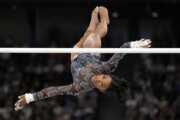SAINT-DENIS, France (AP) — Italy’s Tommaso Gianazza disappeared under the surface, popped up and then disappeared again. Croatia’s Matias Biljaka kept leaning and pushing on Gianazza — their heads right beside each other at times — as white water splashed around the centers.
It looked as if they were trying to drown each other — and it was just an average encounter when it comes to high-level water polo. But actual fights are rare, especially with medals on the line at the Paris Olympics.
There is a line that rarely gets crossed.
“Yeah, sometimes we get beaten up in there,” U.S. center Alex Obert said. “But when you get to score a goal on someone that’s trying to beat you up, there’s no better feeling. So just kind of focusing on the main objective I think really keeps our head cool and nothing better than scoring on someone and then turning around and giving them a little look.”
Gianazza and Biljaka had their encounter in the hotly contested space right in front of the goal — perhaps the most physical real estate in any sport at the Olympics. It is mostly the domain of big hulking centers who resemble human aircraft carriers as they coast through the pool.
Gianazza is listed as 6-foot-4, and Biljaka is 6-6. Josip Vrlic, another Croatian center who is playing in his third Olympics, is 6-6. France’s Michael Alexandre Bodegas is 6-5.
Weight is not a part of the official player bios for the Paris Olympics, but the size and physicality of the centers is noticeable during games. And the imposing centers know exactly where to go on the infrequent occasion when they are defended by a smaller driver or attacker.
“It’s like in basketball, if you have some smaller guy, you rush in and take the advantage of your body, of your size,” Croatia center Luka Loncar said after Tuesday’s 14-11 loss to Italy. “It’s a much better thing for our team because we go closer to the goal or we get an exclusion.”
Exclusions are a major factor in keeping players from taking a swing at their opponents, or even trying to send a message with a well-placed elbow.
Penalty shots and power plays of 20 seconds or 4 minutes can be awarded to an opponent for a violent action. Players can be sent off for the rest of the day, or they could be handed a rare brutality foul that also means they are suspended for at least the next game.
“I think it’s everything about experience now,” Bodegas said. “It’s more than 20 years that I’m playing this position, and now the referees are really, let’s say, careful about the action and violent action. So it’s fair.”
The introduction of video assisted review also has played a role in keeping players in line. Referees have the ability to review the action to take a closer look at a suspicious sequence.
“Everything is getting VAR, it’s getting controlled,” the 37-year-old Loncar said. “Before, if somebody took your arm and then faked, you could have punched him. Now it’s everything has to be clean. And we are especially careful and more calm, and concentrate and then focus on the game.
“You have to be focused on your teammates to help them and not to make a disadvantage, a big disadvantage, if you punch somebody.”
Bodegas, 37, also found his own way of dealing with all that wrestling in front of the goal.
“My mindset, it’s now six years that I’m practicing in meditation,” he said with a grin. “So I think that’s helped me a lot with the situations.”
___
AP Summer Olympics: https://apnews.com/hub/2024-paris-olympic-games
Copyright © 2024 The Associated Press. All rights reserved. This material may not be published, broadcast, written or redistributed.





